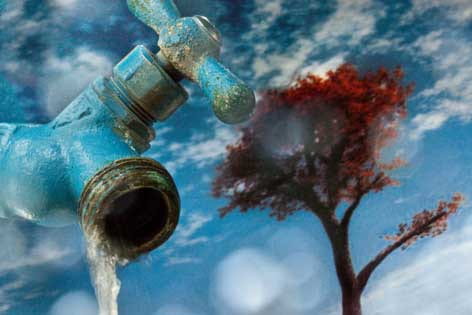Raising water awareness
More than 1 billion people worldwide have unreliable access to clean water. To raise awareness of this and other water issues, UC Irvine is hosting a two-day public event featuring free movies and a panel discussion with local water experts.

More than 1 billion people worldwide have unreliable access to clean water. To raise awareness of this and other water issues, UC Irvine is hosting a two-day public event featuring free movies and a panel discussion with local water experts.
On Oct. 2, “Chinatown” will be shown at 8 p.m. on a giant inflatable screen in Aldrich Park. Screenings of “Flow” and “Riverglass” will begin at 11 a.m. Oct. 3 in the Student Center’s Crystal Cove Auditorium. After a complimentary lunch, the panel discussion gets under way at 1:30 p.m.
In a preview, event co-host Jay Famiglietti, Earth system science professor and director of the UC Center for Hydrologic Modeling, discusses local and global water issues.
Q: What are the big issues regarding water supply?
A: Globally, pollution of lakes, rivers and reservoirs continues to be a major environmental concern, and it has led to the depletion of underground water supplies. In developing nations, insufficient water treatment is a leading cause of disease. Population growth will stress our already overtaxed supply of available freshwater. Global warming will change precipitation patterns, which will affect how much and where surface and groundwater storage is replenished. Since we need water to grow food and for power generation, the supply is intimately linked with food security and energy production. In Orange County, climate change, population growth and freshwater contamination are all determinants of water supply.
Q: Will Californians have enough water in the decades to come?
A: California – and Southern California in particular – has always used more water than is locally available. Whether California’s big thirst can be quenched in the future depends on several factors: How will snow and rainfall amounts change? How rapidly will the population grow? Can new water-transfer agreements be negotiated within river basins, between states or with other countries? Will desalination and water recycling account for a bigger fraction of our state’s water supply? Will Californians be willing to change their water use habits? Can irrigation and crop production be made more efficient? The key to the future of water availability in California lies in the development of a diverse, comprehensive and sustainable water-supply strategy that accounts for these factors.
Q: Where does the water used by Orange County residents come from?
A: Water in Orange County comes from three major sources: Roughly half is imported from Northern California and the Colorado River basin, and much of the rest is local groundwater. Recycling and desalination are beginning to play a larger role in meeting Orange County’s water needs. The actual percentages of each source vary by water district.
Q: How will climate change affect water availability in Southern California?
A: The biggest issue for California and the western U.S. is the reliance on snow in the Rockies and the Sierras for a great deal of the freshwater supply. The snowpack already is shrinking in response to global warming. Climate models predict that by the end of this century, the snowpack will be at just 20 percent of its 1960-90 average size. This will trigger additional groundwater withdrawals, probably at a faster rate than the groundwater is naturally or artificially replaced. So it’s highly likely that climate change will mean significantly less available water in Southern California. Environmental decision-makers must act now to plan for California’s water future.
Q: Will California experience more drought or severe storms in the future?
A: Climate change experts agree the water cycle will intensify in the coming decades. Globally, we expect the overall amount of rainfall will increase, and also the timing of storms will change. Within California, an overall decrease in the amount of rain and snow is projected, more so in Southern California than Northern California. We can expect a smaller number of severe storms and longer dry periods between them. The severity of these storms and dry periods almost certainly will lead to more floods and droughts.
Q: What can society do to make a difference?
A: Use less water! Making a difference starts in the home: Take shorter showers. Fix leaky faucets. Use low-flow showerheads and toilets. Landscape with native plants, and don’t over-irrigate your yard. Wash cars less frequently. Do only full loads of dishes and laundry. Turn off the faucet while brushing your teeth. Reduce your power consumption – power generation requires vast amounts of water for cooling. Most people don’t realize that reducing their water use also reduces energy use. About a quarter of the energy demand in the U.S. is for transporting, heating and treating water.